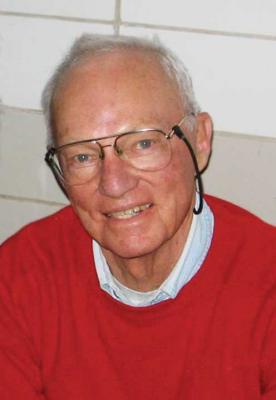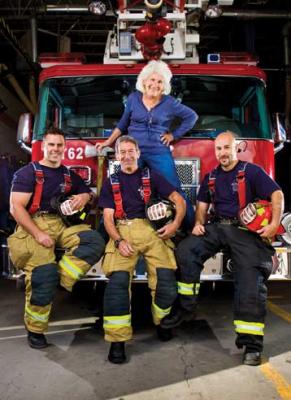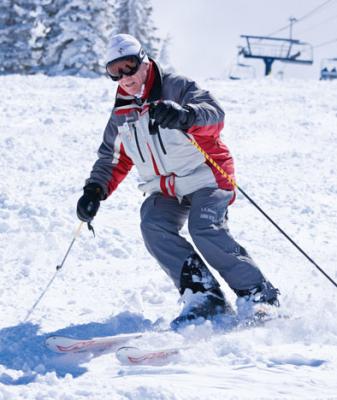Boat People
12/01/2009 01:00AM ● By Jennie Lay
Holiday 2009:
Boat People
by Jennie Lay
Snurfing into the Smithsonian - A conversation with Sherman Poppen, the father of snowboarding Sherman Poppen inventor of the snurferSherman Poppen, 79, conjures up the rowdy crowd at TransWorld Snowboarding’s 1995 Tranny Awards. That’s when the snowboarding industry started honoring innovators for making a lifetime impact on the sport. Sherman got Tranny No. 1.
Sherman Poppen inventor of the snurferSherman Poppen, 79, conjures up the rowdy crowd at TransWorld Snowboarding’s 1995 Tranny Awards. That’s when the snowboarding industry started honoring innovators for making a lifetime impact on the sport. Sherman got Tranny No. 1. As more than 500 snowboarders chanted “You’re the man,” the Father of Snowboarding suddenly realized he’d hucked something huge on snosports back on Christmas Day 1965 when he spontaneously invented the Snurfer – a stand-on-top sledding contraption he screwed together with two 36-inch skis and some molding so his daughters could ride the snow-covered Lake Michigan sand dunes. He tweaked the wooden ride using water skis, grooves, metal edges and a steering leash off the nose, then patented it and licensed the Snurfer to Brunswick (the bowling alley manufacturer) for mass production. Sherman estimates nearly 900,000 Snurfers sold over 15 years.
This summer, the Smithsonian Institution took a stab at trumping the honor of Sherman’s Tranny Award by acquiring the part-time Steamboat Springs resident’s innovation for the national museum’s permanent collection in Washington D.C. Sherman says being in the Smithsonian is “pretty thrilling. But I didn’t give them my Tranny Award. I got Tranny No. 1 and I kept that at home.”Jennie Lay: When did you start snowboarding?Sherman Poppen: I was a heck of a good skier having a heck of a lot of fun. I tried riding a board at age 65, after the Tranny Awards in Banff, Canada. After that I started snowboarding and never went back on skis. I stopped three winters ago. JL: What do you think of snowboarding today? SP: I think it’s pretty fantastic that it’s nomainstream stuff. The number of tickets sold to snowboarders is probably salvaging a number of ski areas.
JL: What did you think of snowboarding when it was making its initial big splash?SP: The real big splash was its first Olympics [in Nagano in 1998]. That was the dramatic moment in the growth of the sport. Before that, they were just having a good time with their cultural effect in the way they dressed. Snowboarders were just having fun.
JL: Howould your Snurfer fare in the Mavericks Superpipe?SP: It wouldn’t be any good at all. Its main joy was riding it in powder. It was mainly a powder board. It could run on two or three inches, but on icy stuff it was pretty dangerous.
JL: Did you ever try to catch big air on your Snurfer? SP: I was never really balanced to be off the ground. But when I was 70 I rode off a helicopter at Alyeska in Alaska.
JL: What exactly did you donate to the Smithsonian?SP: I gave them all of my boards, the prototypes, and all my paperwork, which included the patents and trademarks. In a femonths you’ll be able to go into the Smithsonian Web site and look for everything. I delivered everything personally. All I said was when you put those things on show, write me a letter so I can come back and see it. [Note: According to the Smithsonian Institution’s curator, there is no scheduled Snurfer exhibit at this time. Sherman’s Snurfer collection will reside at the Lemelson Center for the Study of Invention and Innovation at the National Museum of American History.]
JL: When was the last time you actually took a Snurfer for a ride?SP: I rode one for a photo shoot about four years ago. We did it in Steamboat, on the hill right next to my house. The grandkids played on them all the time. They were kind of beat up.
JL: Favorite trail to ride on the Steamboat Ski Area?SP: 2:30 JL: What else do you foresee in downhill snow-riding innovation? Hoabout those ski bikes – any potential for them to evolve and take off like the Snurfer did?SP: I don’t know. It probably could. Any way to get down the hill is fun. Frankly, my biggest fear was getting hit by somebody. I imagine getting hit by one of those would really hurt.JL: You were once an aspiring surfer stuck in Michigan. You invented a way to surf the snow, but did you ever get to surf the ocean?SP: I went for two days in Oceanside, Calif. At the end of 2 days I was standing up.JL: What do the young riders say to you these days?SP: Most of them have no idea who I am. I worked with Steamboat’s ski school for the snowboard classes. I wore a nametag that said “Father of Snowboarding” on it. I just sent that off to the Smithsonian too. Mostly, I posed for a lot of pictures with mom, dad and the kids.JL: Ultimately, the big deal was your patent on metal edges. Why did you let that go?SP: At first, I was riding my Snurfer so much that the edges were getting rounded. I just took an old pair of skis and put metal edges on it. When I filed my patent, my 15th claim was “metal edges on a downhill device” and they granted the patent based on that. But everyone had metal edges on their skis already, so it was in the public domain. But it was kind of fun to have that patent.
JL: You’ve said “it’s hard to be the first.” What do you mean by that? SP: If you go shopping, do you just pick something up and buy it or do you compare? People didn’t knowhat to make of the Snurfer. That’s why it was hard to get started. Another brand, the Banana Peel, came out in the late 60s. It was yelloplastic and it wasn’t very good. It wasn’t fast and it couldn’t turn. That boosted my sales considerably.JL: Any pending offers for a re-release of the classic Snurfer? SP: I tried to do that in the early 80s and it didn’t work at all. This thing is just a back yard toy. I’ve lost all rights to everything.
Want to see an original Snurfer? Tread of Pioneers, downtown at Ninth and Oak streets downtown Steamboat, keeps one on display in the museum’s history of skiing exhibit.
Snurfer BetaDebuts: Christmas Day 1965 in Muskegon, Michigan.First appears on shelves: 1966The original look: Yellowith black stripes and “Snurfy” the cartoon snosurfing boySales: 800,000-900,000 over 15 yearsStarting price: $5.70
Burning Ring of Fire - For John "Pink" Floyd, jumping through fiery hoops is all in a days work
SKIS, CHECK. BOOTS, CHECK. Toboggan, check.Gasoline-soaked towels, check. “It’s a good, clean adrenaline rush,” says John “Pink” Floyd, who soars through a fire hoop trailing a fiery toboggan off Howelsen Hill’s 70-meter Nordic jump every year during Winter Carnival, in a local emulation of the Lighted Man. If there’s a man for the job, it’s Pink, 42, who has worked for the Steamboat Springs ski patrol since moving here from Denver 23 years ago. Ever since fellopatroller Wes Richey nicknamed him “Pink” for obvious rock star reasons, he has made his mark on the mountain. But while the patrol supervisor once helped lead his cohorts to a second overall finish at the National Ski Patrol Championships, dealing with pyrotechnics on alpine skis is a different matter. Pink made his first flying, flaming leap 16 years ago after fellopatroller Bob Heinz bowed out. When the torch was passed his way, Pink admits he “was more scared of chickening out than doing it.” He has been doing it with flying colors ever since. That’s not to say there haven’t been mishaps. “We’ve been through our learning curves,” says Pink, who admits it’s easier to jump with a toboggan than without one, but that the consequences are higher. “A fepeople have gotten pretty close while lighting – Tom Mackenzie once singed his beard while getting the sled ready. But nowe’ve gotten it down to a science. We try to be smart about the fire.” As for equipment wear, he says it’s not an issue. They’ve only used three sleds for the fiery feat in the past 16 years. “In the early years, the sled burned quite a bit, but we’ve learned a lot since then,” he says. The fiery hoop adds drama to the Winter Carnival weekend, and the festival truly embodies the Steamboat spirit, Pink says, making the town a great place to raise his daughters, Jordi, 11, and Katy, 7. “Jordi keeps saying she wants to do it when I’m done,” he says, “but I don’t think that will be anytime soon. I’ll keep doing it as long as I can.” Ever the safety-minded patroller, he adds, “but kids, don’t try this at home.”
Ann Ross, Calender Girl Ann Ross says her horizons expanded while putting together a photo journal
for the VNA, during which she photographed and interviewed more than 100 active Routt County seniors from all walks of life. ANN ROSS HEEDS Eleanor Roosevelt’s advice: “You not only have the right to be an individual. You have an obligation.” Ann is a silver-haired spitfire who part-timed in Steamboat Springs for three decades before relocating in 2005. She has since skied 70-plus days a year, medaled annually in NASTAR racing, politely fielded questions such as “where to buy those pretty red trees” as a volunteer ranger at Fish Creek Falls, and become the revered elder among the local African dance troupe.  Fashioinable Firemen: Ann Ross, posing with Scott Hetrick, Mike Hirshman and Michael Arce, whom she featured in her photojournalism project. Photo by Corey Kopischke. “I don’t have too much bashfulness. If it’s out there I say try it,” Ann says. “If you raise your eyebrows at me, it doesn’t bother me one bit. This is the only life I have and I’m going to have the best time doing it.” Ann doesn’t reveal her age but offers, “I was born in the Depression and I’ll probably die in one.” The daughter of a chemistry and physics professor, Ann had a 35-year career as a pharmacist. She was a working mother of two, the only female in her class. Ann worked in hospital pharmacies and clinics around the Midwest, and owned a historic drug store
Fashioinable Firemen: Ann Ross, posing with Scott Hetrick, Mike Hirshman and Michael Arce, whom she featured in her photojournalism project. Photo by Corey Kopischke. “I don’t have too much bashfulness. If it’s out there I say try it,” Ann says. “If you raise your eyebrows at me, it doesn’t bother me one bit. This is the only life I have and I’m going to have the best time doing it.” Ann doesn’t reveal her age but offers, “I was born in the Depression and I’ll probably die in one.” The daughter of a chemistry and physics professor, Ann had a 35-year career as a pharmacist. She was a working mother of two, the only female in her class. Ann worked in hospital pharmacies and clinics around the Midwest, and owned a historic drug store
in Muscatine, Iowa. She operated a soda fountain where “guys would line up at the bar in the morning waiting for a Bromo-Seltzer to settle their stomachs,” she says – though one might suspect they wanted a peek at effervescent, golden-eyed Ann. Back then she was also a poster model for AT&T.
Those good looks launched Ann as Ms. November in Humana’s 2009 Calendar, an experience that sparked a project that has consumed much of her past year: Ann created a photo-intensive, 52-week datebook for the Visiting Nurses Association that features 125 active locals over age 60. She captured hockey players, firemen, ranchers, skiers, yogis and skeet shooters. “If I could come back in a second life, I’d be a photojournalist and seek people out,” Ann says. “I gained more from this project than I’ll ever be able to give out. It’s been a ball.
Ageless Teacher - Don Gore revels in being resort's oldest ski instructor In 1955, eight years into being a Navy medic, Don Gore saa newsreel of Buddy Werner winning a downhill ski race. Don was hooked on the sport before ever stepping into his first pairof ski boots. Having stockpiled some leave, Don headed for Colorado. It was May and he spent one day at Berthoud Pass Ski Area. "I fell 22 times. I counted," he says. A year later, his enlistment wasup and the budding ski bum headed straight for Crystal Mountain in Washington. He made ski patrol within a year a position he held for 25 years before moving to Steamboat Springs to become a ski instructor. "I never did take any lessons. I just hung out with the better skiers," he says. Noat 78, Don reigns as Steamboat's oldest ski instructor. He earned his lifetime Mogul Maturity: Don, enjoying another senior moment at Steamboat. Photo by Corey Kopischke.ski pass last winter, an honor the Steamboat Ski Area bestows on its 20-year veterans. "I can't wait until I'm 80. That's a milestone to be doing what I'm doing," Don says without a hint of retirement on the horizon. He simply feels lucky that he's finally old enough to qualify for a cozy Selbe Apartment in town (and undoubtedly grateful that he's not making the snowy 150-mile round-trip drive to work from Maybell that he used to do in his turquoise '96 Camaro). Back in the late 1950s, Don did race against Buddy just once. Buddy took the course in 45 seconds and Don finished it in 1:15, a defeat Don is proud to reveal. But he has won his share of races too, including senior national championship titles in downhill and slalom. He takes mischievous pride in beating the younger ski instructors to this day: "Those 250 ski instructors, I'm out-skiing over half of them in the bumps." The key to being the oldest guy in ski school is good physical conditioning, he adds. Don is a certifiable gym rat, and when he can't get to the gym he's got a tricky 20-minute jump-rope workout that would topple most people. "Skiing is all about rhythm. It's hypnotic. The movement is addictive," he says. While he may spend his spare time restoring a '74 Camaro that he plans to cruise up and down Lincoln Avenue one of these days, skiing is still Don's ultimate art. "When I'm skiing, I'm creating," he says. "I'm bringing it back to life."
Mogul Maturity: Don, enjoying another senior moment at Steamboat. Photo by Corey Kopischke.ski pass last winter, an honor the Steamboat Ski Area bestows on its 20-year veterans. "I can't wait until I'm 80. That's a milestone to be doing what I'm doing," Don says without a hint of retirement on the horizon. He simply feels lucky that he's finally old enough to qualify for a cozy Selbe Apartment in town (and undoubtedly grateful that he's not making the snowy 150-mile round-trip drive to work from Maybell that he used to do in his turquoise '96 Camaro). Back in the late 1950s, Don did race against Buddy just once. Buddy took the course in 45 seconds and Don finished it in 1:15, a defeat Don is proud to reveal. But he has won his share of races too, including senior national championship titles in downhill and slalom. He takes mischievous pride in beating the younger ski instructors to this day: "Those 250 ski instructors, I'm out-skiing over half of them in the bumps." The key to being the oldest guy in ski school is good physical conditioning, he adds. Don is a certifiable gym rat, and when he can't get to the gym he's got a tricky 20-minute jump-rope workout that would topple most people. "Skiing is all about rhythm. It's hypnotic. The movement is addictive," he says. While he may spend his spare time restoring a '74 Camaro that he plans to cruise up and down Lincoln Avenue one of these days, skiing is still Don's ultimate art. "When I'm skiing, I'm creating," he says. "I'm bringing it back to life."




